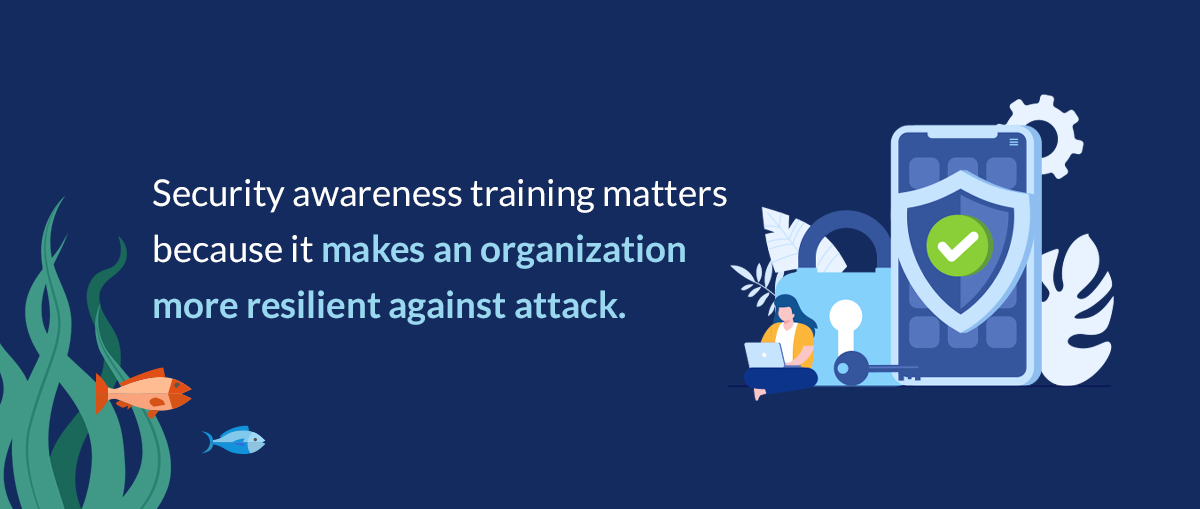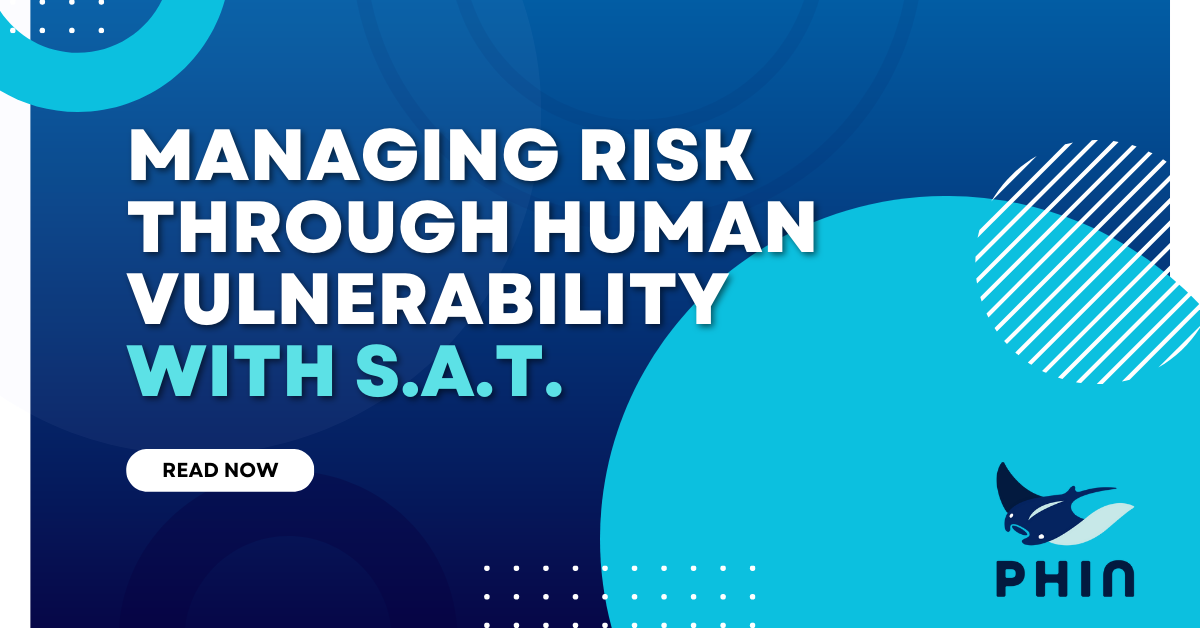


Why Security Awareness Training Matters



The past decade has seen a dramatic upheaval in information security. The volume of malware attacks worldwide jumped from the millions to the tens of billions. Small, disjointed threat actors banded together to create ransomware and Ransomware as a Service (RaaS) firms which are highly organized and highly profitable, driving a multi-trillion-dollar global cybercrime industry.
Businesses can—and do—spend hundreds of thousands to millions of dollars on infrastructure and services to thwart cyberattacks. If not paired with an effective cybersecurity awareness training program, that spending may amount to nothing more than security theater.
Jump To:
- Risks of Avoiding Security Awareness
- Benefits of Cybersecurity Awareness
- Building a Proactive Defense
- Why Training Matters to Clients
The Cost of Ignoring Security Awareness Training
According to IBM's 2023 Cost of a Data Breach Report, the average total cost of a data breach jumped to $4.45 million from $4.35 million in 2022.
Depending on an organization’s industry and services, there are more significant consequences than financial costs. Some organizations may suffer considerable reputational harm—and consequent business loss—due to a security incident.
Other organizations may hold some of the most sensitive data that people have: information about their financial livelihood, healthcare records, and irreplaceable personal information. Protection of company information, especially personally identifiable information, is critical for keeping your organization’s clients safe.
Unpacking the Risks of Inadequate Training
Cyberattacks are at an all-time high. The size and scope of the threat landscape are only growing and are projected to grow from ten-to-twenty-fold by 2025.
The tangible impact of that growth on business is significant. All cybercriminals are looking for ingress into an organization’s finances. There are multiple ways to access that:
- Supply chain fraud: Someone sends fraudulent bills or invoices to many organizations with the hopes that some will pay.
- Business email compromise: The attacker hacks a vendor or client and controls their email to redirect funds, deliveries, and the like.
- Phishing emails: Attackers send a malicious payload to an organization via email to take control of internal resources, encrypt data, abscond with data, and leverage the nefarious work for ransom or use account credentials to steal data and money. Common vehicles include ransomware or malware.
- Social engineering attacks: An attacker calls the helpdesk to gain information about an organization’s operation and access critical resources.
The list goes on.
Those attack modalities have a common thread in that they all rely on deception to con an employee to achieve a goal. Empirical research backs that — as of 2023, phishing emails were the primary attack modality. Why? Human weakness.
The Impact of Cybersecurity on Business Analysis
Cybersecurity campaigns and strategic business planning share several key components:
- Business continuity planning
- Risk management
- Continuous improvement
- Data protection
- Regulatory compliance
Training for both business excellence and employee cybersecurity is also important in that it encompasses several of those points. For example, threat actors look for entry points of resistance, which is why organizations spend hundreds of thousands of dollars bolstering their defenses and building early detection systems inside and out. But all this perimeter preparation means their staff is the point of least resistance.
An organization that takes cybersecurity seriously will treat employee vigilance as the first line of defense for asset protection. That means investing in training programs that truly test employees at every level of the organization.
Unveiling the Comprehensive Benefits of Cybersecurity Awareness
Information security awareness training is a crucial component of any risk management program. It helps inform your staff about what to do, when, and how to defend your organization from costly cyberattacks. Security awareness training is best paired with a robust risk management program that focuses training on specific gaps or vulnerabilities in organizational controls.
Organizational Advantages of Well-Informed Teams
Organizations only managed to catch one-third of breaches using their own security teams in 2023 — revealing a significant need for better threat detection tools and techniques. Security awareness training is one important step in closing that gap.
In addition to suffering fewer data breaches, companies that embrace training often experience a broad spectrum of benefits, including:
- Cost savings: When your employees follow cybersecurity best practices, they'll be better equipped to catch attacks early on, which can save you thousands or even millions in damages.
- Easier compliance: Employees that value security understand their role in protecting the company, which often results in greater adherence to the key cybersecurity regulations your company follows.
- Stronger security culture: Security awareness training helps create a company culture that prioritizes security best practices in every area of business.
Essentially, the more completely your organization embraces security awareness training into its typical workflow, the better your position will be to win clients and keep them with you.
Fortifying Company Data Through Knowledge
Obviously, data security is critical in every industry. But determining how to protect your data — and your client's data — most effectively is often a challenge.
Where organizations really need to work is the middle ground — the areas that are materially impactful to an organization’s security posture and can help mitigate serious threats.
Identifying those threats requires a great deal of effort: evaluation of technical, administrative, and physical risks to identify areas of critical need. That can involve internal and third-party risk assessments, security telemetry monitoring, and evaluation of other data sources for a chance.
Proactive Defense: Regular Security Drills and Incident Response
As with any other type of business risk, being proactive is critical. It's always best to strengthen your security posture before a breach can happen, and regular simulation drills and incident response planning are excellent tools for this purpose.
Simulating Threats to Prepare for Reality
While tailoring your training program to your company's needs can be challenging, being aware of the current cybersecurity landscape can make some of these decisions obvious.
For example, an organization that primarily uses Software as a Service product, also known as SaaS, isn’t likely to meaningfully benefit from intensive secure coding training. On the other end of the spectrum, all organizations benefit from simulated phishing training, given phishing’s prominence as an attack vector.
Measuring the Real-World Impact of Security Training
Training is such a big part of the corporate world that it can be overwhelming for staff at every level of an organization. From HR training aimed at motivating appropriate workplace behavior to professional training intended to develop key skills, the sheer number of training requirements makes training overload and burnout a real concern.
Information security awareness training can often seem like just another screwdriver in the toolbox — you bought it for a reason, and there was a specific need. Still, you can’t remember what that was. Now, it just languishes alongside all the other training that feels the same.
Fortunately, there are ways you can gain visibility into how your security awareness training positively impacts your business.
Calculating Training ROI and Business Impact
The most basic way to calculate your training ROI is by multiplying the average cost of an incident by the number of incidents your organization might experience within a given period of time. You'll end up with the average expected losses for that time frame, which you can compare to the cost of a cybersecurity training program to determine whether the solution and its benefits are worth the investment.
Of course, there are many other factors to consider beyond hard costs:
- Reputational losses
- Intellectual property losses
- Business disruption
A well-designed training solution from a vendor with a proven track record in improving overall security is your best bet for ensuring a strong ROI.
Building a Resilient Cybersecurity Culture

Security awareness training matters because it makes an organization more resilient against attack. Furthermore, it plugs a significant gap common to all corporate environments — human elements of compromise.
Just purchasing and deploying training isn’t enough, though. Like effective expenditures in other information security domains, training needs to address critical areas of vulnerability and be tailored to your organizational needs.
Real-World Preparedness Through Simulation Training
Organizations are well served by evaluating risk, identifying risk criticality, and patching that risk through mitigation and remediation — and simulation training is a great tool for completing those tasks.
For example, phishing simulations present employees with what appears to be a real email from a suspicious sender. Once the recipient either clicks the link or reports the email, a prompt will appear that either congratulates them on making the right choice or walks them through how they could have handled it differently. This hands-on training encourages real learning and recollection, as users have to interact with the content to move on to their next task.
Transforming Mindsets: From Awareness to Habitual Security
Addressing critical areas of vulnerability is relatively straightforward: there’s a wealth of information available through reputable studies highlighting how threat actors use human vulnerabilities to breach a corporate network. Security vendors specializing in training provide vast swaths ranging from phishing to secure coding, architecture, firewall management, etc. If you can imagine it, there’s probably a training module somewhere.
The point of those modules, though, isn't to require more training. The point is to make following cybersecurity best practices part of each employee's daily routine. After all, building good habits is key to lasting success.
The Client-Centric Importance of Security Training
So why does training matter to your clients? There are several reasons, many of which we have already covered in this article:
- Training drives beneficial procedural and behavioral change.
- The prevalence and sophistication of information security risks are rising sharply with no signs of abatement.
- The consequences of a breach are extreme and expensive.
- Security awareness training drives beneficial change in your organization to mitigate risks and avoid the consequences of those risks.
To address these points, many large corporate or institutional organizations implement Third Party Risk Management (TPRM) evaluation programs. A TPRM program is focused on identifying third-party risk. Typically, those programs involve perimeter scans of a service provider’s public-facing environment, a service provider’s reported data breach history, and evaluations of a service provider’s security controls. A modern and sophisticated information security threat training program is included in that security controls evaluation.
Earning Trust Through Robust Cybersecurity Measures
Your clients entrust you with their information to provide goods and services. In many industries, they entrust their lives and livelihoods to you. There is no quicker way to erode trust than by exposing their information to the world. A data breach directly impacts their lives and livelihoods for the worse.
The converse also holds true, though — there is no better way to build trust than highlighting how you secure their most sensitive and precious information. If your clients know that you provide your staff with information security training, they'll be more confident in your ability to safely maintain their data.
Even better — if your clients know that you’re engaging in a risk-based approach to information security training, it demonstrates that you’re protecting their information to a high degree and with sophistication. You’re signaling that you have a whole program focused on data maintenance and management informing your training program — and, likely, other compliance activities.
Articulating the Importance of Security Training to Your Clients
Transparent communication can turn your cybersecurity program from a cost center into a revenue center. By flipping the script from cybersecurity as insurance to cybersecurity as a business enabling and supporting function, you can show your clients how you respect their data and take their data custody concerns seriously. You may find that you’ll draw security-conscious clients and recoup some of your investment in cybersecurity.
Corporations and other institutional organizations, such as business and cyber insurance providers, may also insist on the existence of a training program via contract. This agreement will usually require regular elaboration about the details of that program. Insurers are faced mainly with increasing costs due to organizations failing to implement industry-standard information security controls, which require organizations to demonstrate their compliance to maintain coverage or receive a payout in the event of a catastrophic cyberattack.
Communication about your training might be more difficult if your clientele is mainly individual. While most consumers understand a data breach and its impacts on their data, few understand the importance of a solid risk-targeted training program. The key here is using plain language to emphasize the controls you’ve implemented and the safety benefits they bring to the table.
Here are some recommendations for how to communicate aspects of your security program:
- Emphasize integrity and how that impacts your clients
- Discuss your safety-oriented culture
- Highlight your focus on staff development and customer service
Creativity in this space can help you really make your training efforts shine!
Take Action With Phin Security
Your training program is critical to clients because of what it represents, which is a robust and sophisticated approach to information security risks and data management. Making sure you’re communicating that in the right way to the right audiences is a must if you want to further capitalize on your cybersecurity defense efforts.
That's where Phin Security's revolutionary Security Awareness Training software platform comes in. Our robust content library makes it easy for you to create a simulated phishing program that effectively prepares your organization for real-world threats. You'll also gain access to real-time analytics that provide insight into your security risk, which can help you impress your clients.
Ready to get started? Start a Free Trial to see our platform in action.







Leave a comment: